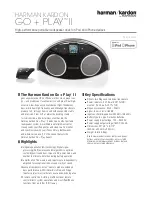
28
Bi-amping (horizontal)
In a bi-amping arrangement the signal paths for the bass
and mid-range/treble ranges are separated before they
reach the power amplifiers.
In the
horizontal
bi-amping version, one stereo power
amplifier is used to amplify the bass range for both
channels, while a second stereo power amplifier drives
the mid-range/treble range of both channels.
Advantage
: symmetrical load on the power amplifier
mains power supply for both channels.
Disadvantage
: the power amplifier determines the
channel separation.
The bridge pieces between
TT
and
MT
/
HT
must be removed!
Bi-amping (vertical)
In the
vertical
bi-amping version the power amplifiers
work in a strictly channel-separate arrangement.
One stereo power amplifier amplifies the signals for one
loudspeaker: one channel drives the treble/mid-range,
the other channel the bass range.
Advantage
: maximum channel separation in the power
amplifiers. Power amplifiers can be located close to the
speakers, therefore short speaker leads can be used.
Disadvantage
: asymmetrical load on the power amplifier
mains power supplies due to bass processing on one
side and mid-range/treble processing on the other.
The bridge pieces between
TT
and
MT
/
HT
must be removed!
All manuals and user guides at all-guides.com









































